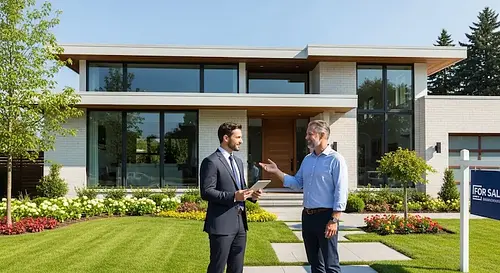What Is Farming In Real Estate? The Ultimate Guide For Agents
Real estate farming—also called geographic farming—is a proven marketing strategy to build long-term authority in a specific neighborhood or niche. In this guide, you'll learn exactly what farming is, how to pick the right market, and the step-by-step system top agents use to become the go-to realtor in their neighborhood.

Written by Seth Cox
Jul 04, 2025 / Real estate lead generation
Farming in real estate, often called Geographic Farming, is a proven marketing strategy that involves choosing a specific geographic area or niche market and consistently marketing to it over time. Much like traditional farming, you "plant seeds" through direct mail, open houses, social media, phone calls, and other outreach. With consistency and value, those seeds eventually grow into listings, referrals, and repeat clients.
This isn’t about one-off cold calls or sporadic postcards. Real estate farming is about dominating a neighborhood, demographic, or digital space by becoming the agent people think of first.
In this complete guide, you’ll learn:
- What real estate farming really means
- The different types of farming strategies agents use
- How to choose the right farm area (and avoid wasting time)
- Real Estate farming tactics like postcards, open houses, and circle dialing
- Tools and tech that help you farm smarter, not harder
- Common mistakes to avoid and how to track your success
Whether you're a brand-new agent or looking to scale your business, farming gives you a structured, repeatable way to build influence and drive steady income. Let’s dig into how it works—and how to get started.

Real Estate Farming Definition and Benefits
What Does Farming Mean in Real Estate?
Unlike general prospecting or one-time campaigns, farming is about creating a steady, long-term presence. It’s not unusual for agents to work the same farm area for years—and those who stay consistent often become the dominant listing agent in that neighborhood.
Why Real Estate Agents Use Farming Strategies
- It builds local brand authority. When homeowners see your name over and over, they start associating you with real estate success in their area.
- It creates inbound listing leads. You become the first person people call when they’re thinking about selling.
- It generates referrals. Even neighbors who aren’t selling may recommend you to friends and family.
- It supports all stages of the sales funnel. From awareness to nurture to conversion, farming keeps you visible every step of the way.
- It’s a long-term asset. Done right, your farm becomes a marketing machine that pays off year after year.

Types of Real Estate Farming Strategies
Let’s break down the most effective real estate farming methods:
Geographic Farming for Real Estate Agents
- Know the area well or live nearby
- Track turnover rates and competition to choose the right farm
- Use direct mail, local events, and open houses to build visibility
- Stay consistent with monthly touches and market updates
Geo farming is especially powerful in areas with steady home values and a healthy turnover rate. When you become a familiar face in a tight-knit community, trust builds fast—and listings follow.
Niche and Demographic Farming in Real Estate
- First-time homebuyers
- Luxury property owners
- Seniors looking to downsize
- Real estate investors
- Probate or divorce leads
This type of farming works well for agents with personal experience in the niche, or access to tailored services and resources.
Digital Farming for Real Estate Leads
Effective digital farming includes:
- Posting in local Facebook groups
- Running geo-targeted ads on Instagram or Google
- Creating YouTube videos about your farm neighborhood
- Sending monthly email newsletters with market insights
When done well, digital real estate farming creates a virtual version of local visibility—and it keeps you top of mind for mobile-first consumers.

How to Start Farming in Real Estate: A Step-by-Step Action Plan
Step 1: Define Your Real Estate Farm and Set Clear Goals
How many touches will you make per month?
- What’s your listing goal over 6 or 12 months?
- What’s your budget?
Clarity at the beginning helps you stay consistent and accountable when results take time to show.
Step 2: Build a Contact List for Your Farm Area
If you’re using a service like RealMailers.com, you can target properties directly on a map—even if you don’t have a list in hand.
Pro tip: Start a spreadsheet or import your list into your CRM to track who you’ve contacted and how they’ve responded.
Step 3: Choose Your Marketing Channels and Content Strategy
- Monthly handwritten notes and newsletters
- Market updates or “just listed/just sold” alerts
- Email drips for homeowners (using a tool like Follow Up Boss)
- Local Facebook group posts or community videos
- Open house invitations
- Circle dialing to nearby homes
Each touchpoint reinforces your name and value as the local expert.
Step 4: Build a High-Impact Monthly Farming Schedule That Covers Every Home
Here’s a proven monthly schedule that hits every home in your farm:
- Mail 1 Postcard to Every Home Each Month - Use farming postcards to deliver just listed/sold updates, market insights, or seasonal homeowner tips. Services like Real Mailers make it easy to map your area and automate delivery.
- Host 4 Open Houses in Your Farm Monthly - That’s one per weekend. Even if the listing isn’t yours, open houses let you meet neighbors, generate buyer leads, and create buzz. Use Showable to capture every sign-in and follow up automatically.
- Knock Every Door in the Farm Once a Month - Bring a friendly script, leave behind a branded flyer, and offer value—like a local market update or invitation to an open house. Don’t just drop materials—talk to people.
- Call Every Household in the Farm Monthly (Circle Dialing) - Focus your calls around relevant events: a new listing, a recent sale, or changing market trends. Ask helpful questions, offer insights, and see who’s thinking of selling next.
This may sound like a lot—but agents who commit to full-farm coverage every month are the ones who build real mindshare. Farming is about frequency and familiarity. The more touches you make, the faster your name becomes the default choice when someone’s ready to list.
Step 5: Track Results and Adjust Your Farming Strategy Over Time
- Response rate on mailers or calls
- Website or landing page visits
- Number of leads and appointments booked
- Listings taken from the farm
Over time, double down on what’s working—whether that’s more postcard frequency, better circle dialing scripts, or targeted digital ads.

How to Choose a Farm Area in Real Estate
Here’s how to evaluate and select a geographic farming area that actually works.
Choose a Farm Area with a Strong Home Turnover Rate
A neighborhood with a high turnover rate means more opportunities to win listings. Ideally, you want to target areas where at least 5% to 7% of homes sell each year. Anything lower might not justify the marketing investment.
Turnover Rate (%) = (Number of Homes Sold ÷ Total Number of Homes) × 100
Avoid Oversaturated Markets with Too Many Agents
Make Sure Home Prices Align with Your Business Goals
Target a Neighborhood Size You Can Consistently Farm
Focus on Areas Where You Have Local Knowledge or Presence

Real Estate Farming Postcard Marketing: What to Send and Why It Works
Here’s how to make sure your real estate postcards don’t just get seen—they get remembered.
What to Include in a High-Converting Farming Postcard
- Your branding — name, photo, contact info, and brokerage
- Relevant local market data — average price, days on market, or sale-to-list ratio
- Social proof — recent homes you’ve sold, preferably with visuals
- A clear call to action — like “Get your free home valuation” or “Come to this weekend’s open house”
- Bonus tip: Add a QR code linking to your website or a Showable-powered landing page for open house RSVPs or seller guides
Best Real Estate Postcard Ideas for Farming Campaigns
- Just Listed – Build anticipation and show that you’re active
- Just Sold – Prove your ability to close and raise curiosity about value
- Market Update – Position yourself as the local expert
- Homeowner Tips – Offer seasonal maintenance checklists or seller advice
- Event Invites – Promote open houses, garage sales, or client appreciation events
- Service Offers – Offer a free CMA, equity review, or pre-listing consultation
Postcards are one of the few ways you can get directly into every home in your farm—no algorithms, no email filters. When used monthly and paired with door knocking and digital content, they multiply your exposure.
Need help designing one? Tools like Canva or PostcardMania offer real estate-specific templates you can customize in minutes.

Circle Dialing for Real Estate Farming: How to Generate Listing Leads by Phone
What Is Circle Dialing in Real Estate Farming?
Think of it as “just listed/just sold” mailers—but with a personal voice.
How to Use Circle Dialing Effectively in Your Farm Area
- Call consistently every month. One-time dialing won’t make an impression—set a schedule to hit every home in your farm at least once per month.
- Tie your call to recent activity. Whether it's a new listing, sale, or open house, use it as a natural reason to start the conversation.
- Keep your script conversational and helpful. Don’t hard-sell—ask questions, offer insights, and be a resource.
“Hi, this is [Your Name] with [Your Brokerage]. I just helped sell a home right around the corner from you at [Street Address]. It went under contract in [X] days. Are you curious what that means for your home’s value?”
If they say yes, offer a free market snapshot. If they say no, thank them for their time—and follow up with a postcard or door knock later that month.
Tools to Make Circle Dialing Easier and Compliant
- Use tools like REDX, Landvoice, or Vulcan7 to get homeowner phone numbers with filtering options.
- Track all calls, responses, and follow-up tasks in your CRM (like Follow Up Boss or KVCore).
- Respect do-not-call lists and always follow local telemarketing laws.
Circle dialing becomes even more effective when layered with other touches. For example, after hosting an open house, you can call surrounding homeowners to let them know how it went—and ask if they’ve considered selling

Open Houses for Real Estate Farming: Turn Walk-Ins Into Listing Leads
Why Open Houses Are Essential for Farming Success
- Personally engage with neighbors, not just buyers
- Showcase your marketing approach to future sellers
- Collect contact info for your CRM using a tool like Showable
- Create social media and postcard content (“Open House This Sunday!”)
- Follow up with guests and nearby homeowners after the event
Even if it takes hosting an open house for another agent, open houses in your farm area keeps your face—and your signs—visible week after week.
How to Maximize Open House ROI in Your Farm
- Door knock the surrounding homes to invite neighbors personally
- Send a postcard or flyer the week before to drive attendance
- Use Showable to capture every guest’s info and tag them by neighborhood
- Follow up with neighbors after the event with a “Here’s how it went” message
- Post photos or behind-the-scenes video on Instagram and Facebook
Consistency is key: aim for one open house per weekend within your farm to maintain visibility and momentum.

Door Knocking for Real Estate Farming: Build Trust One Conversation at a Time
Why Door Knocking Works in Geographic Farming
Introduce yourself and your brand in a natural, personal way
- Deliver physical marketing materials (postcards, flyers, market reports)
- Invite neighbors to your open houses or events
- Offer home valuations or local market updates
- Stay top-of-mind by showing up monthly
Homeowners are more likely to call the agent they’ve spoken to—and who shows up regularly—when it’s time to sell.
Tips for Successful Door Knocking in Your Farm Area
- Bring value. Don’t just say hi—offer something useful (e.g. “Just sold update,” “Local market report,” or “Invitation to this weekend’s open house”).
- Track your visits. Use a CRM or spreadsheet to note who you spoke to and what they said.
- Respect privacy. If no one answers, leave a branded door hanger or postcard.
- Be consistent. Door knock every home in your farm once per month.
- Practice your script. Keep it short, friendly, and centered on helping—not selling.
Example intro:
“Hi, I’m [Your Name] with [Brokerage]. I work with a lot of homeowners here in [Farm Name], and I just wanted to drop off a quick update about what’s selling nearby. If you’re ever curious what your home might be worth, I’m happy to run a quick report—no pressure at all.”

How Long Does It Take for Real Estate Farming to Work? Setting Expectations for ROI
Here’s how to think about timelines and performance when launching a geo farming campaign.
Real Estate Farming ROI Timeline: When Will You See Results?
Farming is like building a brand in a mini-market. The first few months are about introducing yourself. The next few are about building recognition. Then the real momentum starts.
What Metrics Should You Track in Your Farming Campaign?
- Response rate on postcards, calls, and door knocks
- Engagement rate from open house invites or QR codes
- CRM activity: new contacts added, conversations started, follow-up actions
- Appointments booked from your farm
- Listings taken directly attributed to farming touchpoints
Use a simple spreadsheet or CRM reporting dashboard to monitor trends month over month. If you notice consistent engagement—like homeowners asking for market updates, replying to postcards, or attending events—you’re on the right path.
Farming Is a Long Game—But the Results Compound
Common Mistakes to Avoid in Real Estate Farming
Mistake #1: Choosing a Farm That’s Too Large or Too Random
Instead: Choose a geographic farm of 500 to 2,000 homes. Make sure the turnover rate and competition are manageable. Go deep, not wide.
Mistake #2: Giving Up Too Early
Instead: Commit to at least 6–12 months of consistent farming. The agents who stay the course are the ones who dominate the neighborhood.
Mistake #3: Being Inconsistent with Outreach
Instead: Stick to your monthly plan—1 postcard, 4 open houses, 1 full door knock, and 1 round of circle dialing every month.
Mistake #4: Focusing on Yourself Instead of the Homeowner
Instead: Offer value-first content—market insights, seller tips, home maintenance advice, or local event invites. Be helpful before you ask for business.
Mistake #5: Not Tracking Results or Optimizing Over Time
Instead: Track engagement, follow-up success, and listing conversions in your CRM. Adjust your strategy based on real data—not guesses.

Best Tools and Technology for Real Estate Farming
Top Platforms for Real Estate Postcards and Direct Mail
- Real Mailers– Target homes on a map without a list. Great for just listed/just sold and monthly touch campaigns.
- PostcardMania – Print and mail service with real estate-specific templates.
- Every Door Direct Mail (EDDM) – USPS program for blanket coverage of a postal route. Cost-effective for large farms.
- ProspectsPLUS! – Robust direct mail platform with pre-built farming campaigns and customizable content.
Real Estate CRMs for Farming Follow-Up
- Follow Up Boss – Ideal for teams and agents who want automation and strong integrations.
- KVCore – Built-in lead capture tools, automation, and campaign tracking.
- LionDesk – Affordable and simple CRM with texting and drip capabilities.
Showable: The Best Open House Tool for Farming Leads
- Digitally sign in guests and tag them by neighborhood
- Automatically sync attendees to your CRM
- Trigger follow-up emails or texts
- Track ROI on each open house event
Bonus Tools for Smarter Farming
- Canva – Design professional postcards, flyers, and social content without a graphic designer.
- REDX or Vulcan7 – For circle dialing and neighborhood phone number lists.
- Google My Business – Helps you show up in local searches and build reviews within your farm area.
- Meta Ads Manager – Run geo-targeted Facebook and Instagram ads to stay in front of your farm online.
Real Estate Farming FAQ: Answers to Common Agent Questions
How Big Should My Real Estate Farm Be?
How Often Should I Contact My Farm Area?
- 1 postcard
- 1 phone call (circle dialing)
- 1 door knock
- 1 open house every weekend
Can Real Estate Farming Work in a Low-Turnover Neighborhood?
Should New Real Estate Agents Try Farming?
Even if you’re on a limited budget, you can start small with 500 homes and grow over time. Just be consistent—and always lead with value.
Is Digital Farming Enough on Its Own?
- Direct mail
- Circle dialing
- Door knocking
- Open houses
- Local content and social visibility
Together, these create a multi-channel presence that keeps you top of mind across every platform.

Final Thoughts: Is Real Estate Farming Worth It?
When done right, geo farming turns cold neighborhoods into warm leads. It builds a pipeline of future listings, referral relationships, and repeat clients who already know your name—before they ever need your help. To succeed:
- Choose the right farm size and area
- Commit to 12+ months of consistent contact
- Layer postcards, open houses, calls, and door knocks
- Track results and refine your message over time
- Use tools like Showable to automate and streamline your strategy
Start small. Stay consistent. Own your farm.






